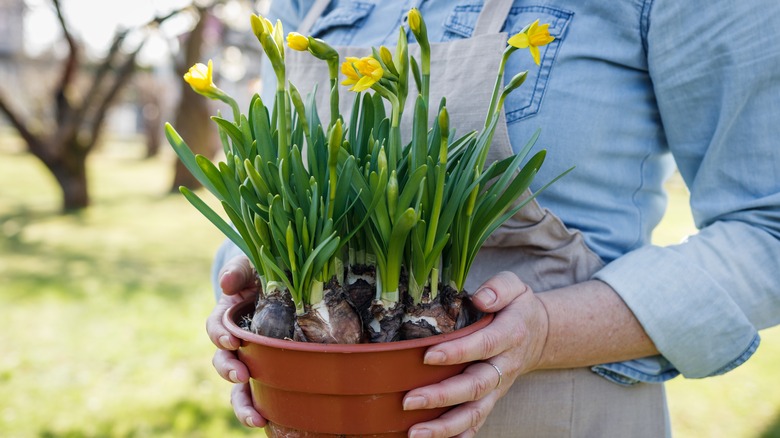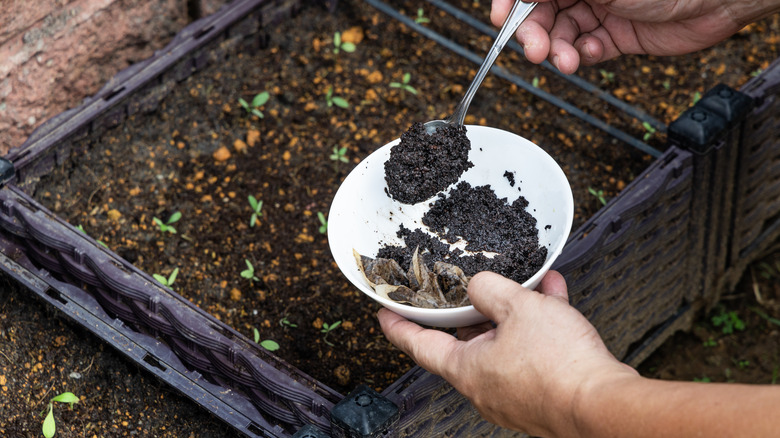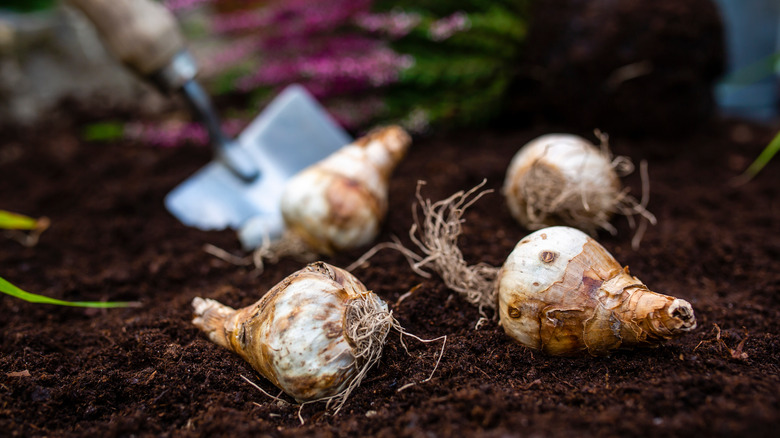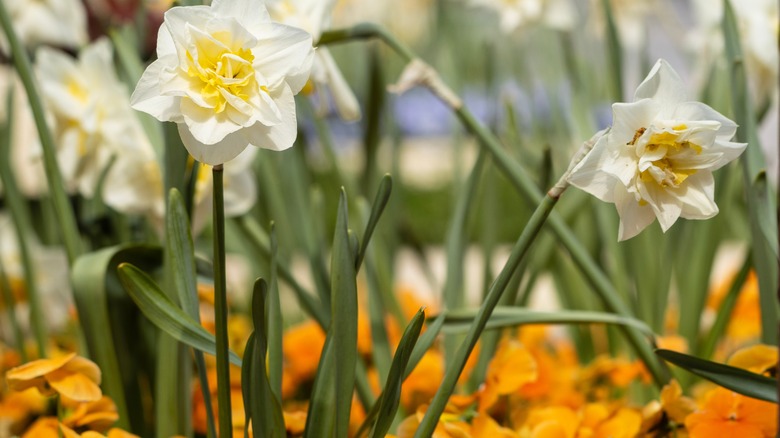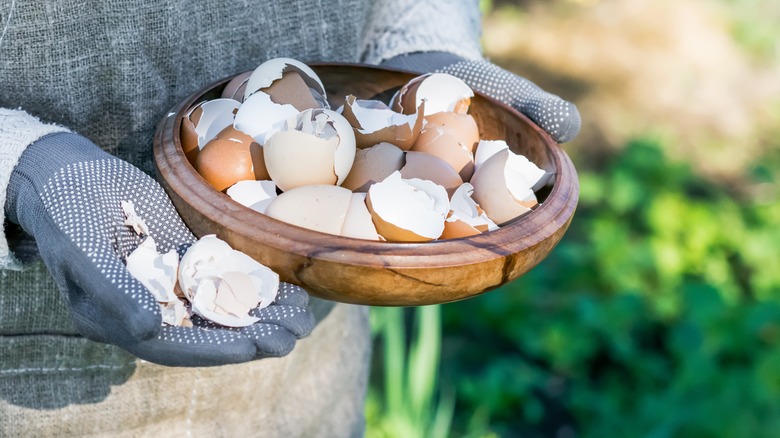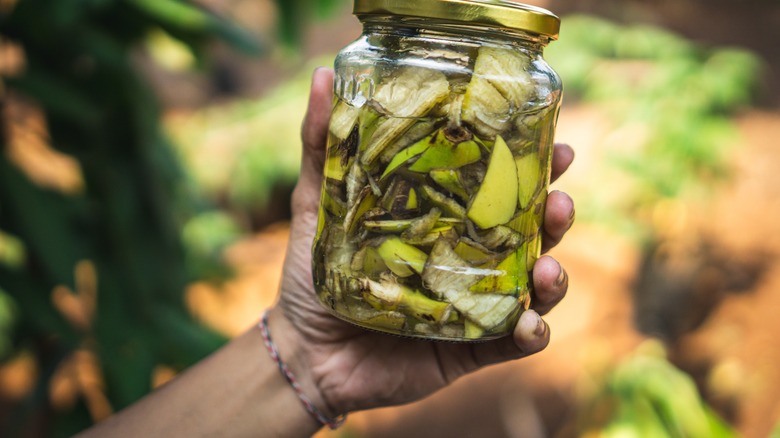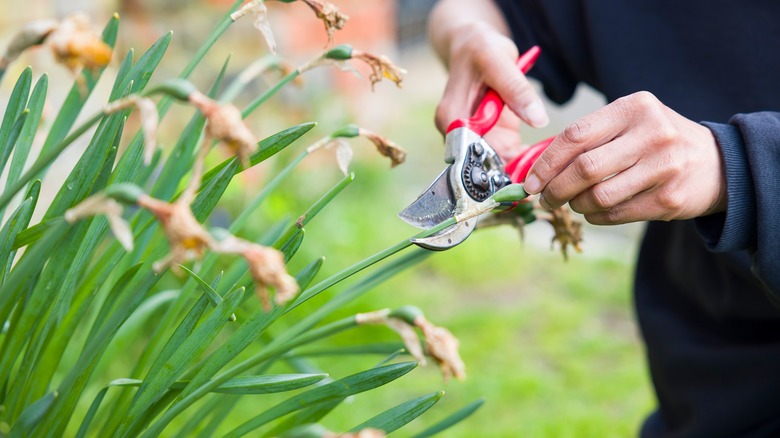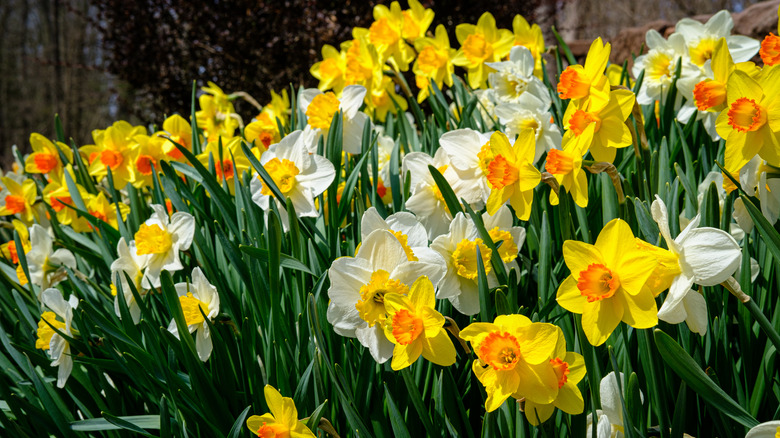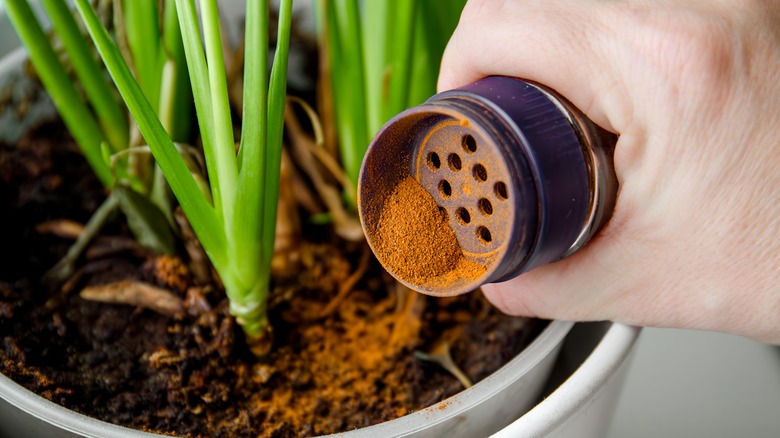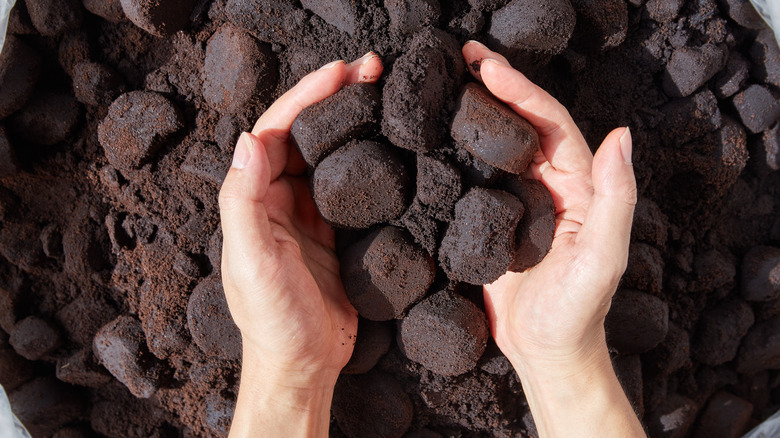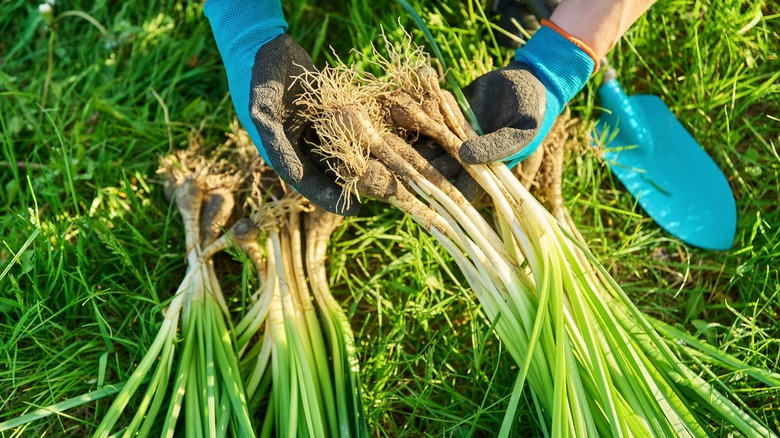Clever Tips And Tricks For Growing Daffodils
Growing sunny daffodils is a great way to get bursts of color each spring, but getting the brightest colors or most blooms comes down to more than planting and hoping for the best. Instead, you should consider adding specific techniques that can boost your plants' health so they create the brightest flowers possible. Instead of getting the same old gardening advice that everyone parrots, you'll hone in on daffodil-specific growing strategies to make your plants thrive.
For example, did you know there are things you can use as fertilizer that stray from the traditional, commercial-grade ones? What about the benefits of planting in clusters or pruning them a certain way to encourage more flowers next year? Using household ingredients like eggshells or cinnamon can do wonders for your daffodils, as long as you do it correctly. Our goal is to give you ideas that use everyday items to boost your plant's output, but each tip or trick has a right and wrong way to go about it.
You want to approach these methods knowing how to use them to get the biggest benefits possible and avoid the common pitfalls that could stunt your daffodils' growth. Understanding the fine details is key to ensuring you don't have sparse flowers next spring after you worked so hard on them. Prepare to set yourself up for success and your garden apart this spring.
Apply coffee grounds as fertilizer
Mixing coffee grounds around your daffodils gives the plants several benefits. First, coffee grounds have a decent nitrogen content, encouraging your daffodils to grow strong leaves. They also have magnesium and potassium. The grounds improve the soil structure to make it drain better and allow air to the roots, and it's critical because daffodils love well-draining soil..
Pull the spent grounds from your machine to fertilize garden daffodils with coffee grounds. Spread them out to dry to prevent mold growth later, and sprinkle the dry grounds around the base of your plants. Gently turn up the top inch of soil to mix them in with your fingers or a hand rake, and apply them early in the spring or around established plants as a top dressing.
You'll only need a thin layer around the plants. You also want to avoid using fresh coffee grounds because they're too acidic and can stunt growth. The caffeine residue can inhibit seed growth, so don't mix it into the soil where seeds haven't sprouted. Stick to using them around established plants to enrich the soil safely.
Plant at the correct depth to ward off cold damage
Planting your bulbs at the correct depth is critical to having them bloom. The sweet spot for planting depth shields your bulbs from cold and temperature fluctuations. You want to bury them two to three times the bulb's height (roughly six to eight inches deep) to insulate them. The bulbs will get enough room below the surface to anchor, stopping them from getting pushed too close to the surface during the freeze-thaw frost heave cycles. It also encourages strong root development before the ground freezes, ensuring your daffodils can sprout in the spring. Plant the pointy end up, drop it in the hole, backfill it with soil, patting it to remove air pockets. Water lightly to settle the soil.
Be careful with the planting depth because the incorrect depth can have adverse effects. If the bulbs go too deep, they might sprout later or struggle to get through the soil. Planting them too shallowly makes them more prone to issues with frost heave, and animals can get to them. Getting as close to the recommended depth is ideal, adjusting for your climate and conditions. You may need to be closer to eight inches for sandy soil or colder climates to protect the bulbs.
Stake your daffodils for support
Staking daffodils is one way to ensure the stems don't bend under the flowers' weight, especially if you live in a windy spot or plant taller varieties. The stakes help stop the stems from snapping. Support is critical for the looks and health of your plants; broken or bent stems are vulnerable to pest infestations or diseases. Staking also ensures your flowers are visible and can effectively photosynthesize.
To stake daffodils to keep them blooming and from falling over, pick stakes that are tall enough to support the full height of the daffodils. Bamboo is popular because it's sturdy and blends nicely with the foliage. Insert the stake at a slight angle near the plant to avoid damaging the roots but close enough to provide support. Tie the daffodil to the stake with a soft strip of cloth or twine, loosely enough to allow movement but maintain stability. Be careful not to tie the material too tightly as it can constrict the stem, hindering nutrient uptake. Regularly check and adjust the ties throughout the growing season to ensure the support remains safe and effective.
Add eggshells to the soil for extra calcium
Adding eggshells to the soil can increase the calcium levels, encouraging healthy growth. Calcium plays a role in helping develop plant cell walls, and by making them stronger, your daffodils will be sturdy. Calcium also helps regular soil acidity and improves the structure so water can reach the roots while deterring snails or slugs that can eat the plants. The sharp edges on the shells discourage these pests from crawling over them to ward them away.
To use eggshells in your garden, rinse collected shells to remove any yolk or egg white residue because these can draw pests. Leave the shells to dry in a sunny windowsill or pop them in the oven at 200 degrees Fahrenheit for 10 minutes. When they're dry, crush them into small pieces or turn them to powder in a food processor to encourage faster nutrient release and sprinkle them around your daffodils' bases, mixing them into the top inch of soil. Apply them when you plant the bulbs or early in the spring so the calcium has time to get into the soil before your plants take off. You should only apply them once per season to avoid overloading the soil.
Add organic banana peel tea for potassium
A little-known fertilizer hack for lawns or plants is making banana peel tea because it adds potassium to the soil. This nutrient helps your daffodils resist disease issues and produce large flowers. It also helps with photosynthesis, strengthens flowers and stems, and ensures water, nutrients, and carbs move through the daffodils.
To make this tea, collect organic banana peels so you don't add pesticides to the oil. Chop the peels into small pieces to encourage faster nutrient release, and pop them into a jar with water. Seal and let it steep for at least a few weeks at room temperature in a dark spot to encourage the potassium to leach out to create the fertilizer. Carefully strain the liquid to remove the solid pieces and pour it directly around the daffodils at their base. Wait for early morning or late evening to do this so it can soak into the ground instead of evaporating.
You must use organic banana peels because non-organic ones can have pesticide residue that can hurt your plants. It's also important to note that potassium is good in small doses, so overdoing it can lead to imbalances. Restrict the use to once a month to give your daffodils supplemental potassium without disrupting the soil's nutrients.
Practice chop and drop pruning to enhance next year's blooms
Chop and drop pruning is a way you can boost your bloom quality next spring. With this method, you cut back the daffodil leaves when they turn yellow and wilt after they bloom, leaving a portion of the leaf on the daffodil for photosynthesis. The leaves you leave will keep synthesizing nutrients, especially carbohydrates, which go to the bulbs. These nutrients help your bulbs build a strong reserve, and they'll pull this for the following spring's blooming cycle. Strategically pruning the leaves close to the ground gives the plant enough material to feed the bulb without exhausting it. It also tidies up your garden because diseases can spread on decaying material.
Monitor your plants when they finish their blooming period. Once the blooms fade and the foliage starts to change color (roughly four to six weeks), this tells you the plant is going dormant. Cut the leaves down to the soil with clean, sharp shears. Make clean cuts to prevent tearing, which can damage your daffodil's vascular system. Leave non-diseased cut plant material on the ground to decompose into the soil and inject nutrients. Timing is critical because cutting them too soon can deprive the bulb of nutrients and reduce flowering the following spring.
Plant in clusters for a fuller look
Daffodils are one of the bulbs to plant in the spring in clusters to get a lush, full look. With this method, you plant five or more bulbs close to mimic how daffodils grow in the wild. Grouping the bulbs enhances the blooms' visual impact, filling your space. Also, clustering them gives mutual support because the flowers can lean on one another and be more wind-resistant. It makes the plants less prone to bending or breaking, keeping them more resistant to diseases and boosting pollination dynamics.
Once you pick out a spot and add compost to the soil, arrange the daffodils in groups of five or more. Plant them roughly six inches deep for regular-sized bulbs and three times their height for smaller bulbs. At a minimum, they need to be four to six inches apart. This depth protects the plants from frost while giving them enough room for each plant to thrive without space competition. Avoid planting tighter clusters, which can cause nutrient competition and stunt plant and flower growth. However, spacing them four to six inches apart also means you'll dig them up and split them every three to five years, so if you'd rather wait to split, increase the space to six to 12 inches per plant.
Use cinnamon for a fungicide
One neat way to use cinnamon around your garden plants or flowers, including daffodils, is to help fight fungal diseases. Cinnamon has cinnamaldehyde, a natural compound with potent antifungal properties. Sprinkling it on the soil can stop fungal spore growth and keep plants healthy. It's a simple, cost-effective, eco-friendly preventative measure, and it helps ensure your daffodils stay healthy and vibrant all spring and summer. It's especially powerful in humid or damp climates because excess moisture encourages fungal infections.
Sprinkle a thin layer of ground cinnamon directly onto the soil around your daffodils. Focus on the areas around the stems where moisture can build up and give fungi a breeding ground. Reapply the cinnamon every few weeks, especially after heavy rain or watering sessions, to help keep the protective barrier. However, note that cinnamon usually won't be powerful enough to fight all types of fungal diseases by itself. You want to use it as part of a broader plant care strategy that includes proper spacing and good watering practices to encourage good air circulation. How effective it is will depend on environmental conditions, and it works best in warm, dry climates because it sits on the soil better instead of getting washed away.
Use charcoal to control weeds and improve the soil
Charcoal mulch prevents weed growth in the garden or around plants, and this reduces the competition your daffodils have. When you add it, it'll improve your soil's structure by making more air pockets and easier to retain moisture. Your daffodil bulbs take advantage of this to grow strong roots. Also, charcoal naturally suppresses weed growth by blocking light from reaching the soil and stopping germination. Your daffodils will have less competition for water and nutrients, allowing them to grow and thrive.
To add charcoal to the garden, pick a wood-derived option and crush it into smaller chunks or powder. Before you do, put on eye protection, gloves, and a mask so you don't accidentally inhale the powder. Also, it's messy, so choose your clothing carefully. Spread a layer of crushed charcoal over the soil around your daffodils, and gently mix it into the top few inches of soil. However, don't overload the soil because charcoal can change the antimicrobial colonies in the soil, and this slows down decomposition, especially bamboo-based charcoal.
Split the plants every few years to improve plant health
Dividing your daffodil clumps every four or five years is essential to keep them healthy and thriving. As they grow, they form tight clumps that can get overcrowded and make them compete for space, nutrients, and light, stunting their growth and blooms. Splitting them reduces completion, giving each bulb the resources it needs to thrive. This simple process helps keep the space neat and makes more air circulate in each plant to reduce the chances of fungal growth. It also invigorates your plants and allows you to spread your flowers.
To divide your bulbs, wait until the foliage dies back, but you can still see it, usually in late spring or early summer. This makes it easier to spot clumps and minimizes how much you disrupt your plants. Get a garden fork and gently lift the bulbs from the ground, working slowly so you don't damage them. Shake the excess soil from the clumps and separate them by hand. You want to be very gentle to avoid physically damaging the bulbs because this leaves open spots for disease to take hold. Replant the bulbs as soon as possible so they don't dry out, and plant them at the same depth and spacing. Water the newly planted bulbs to settle the soil. Also, note that the stress of moving them may cause smaller blooms the following spring.
